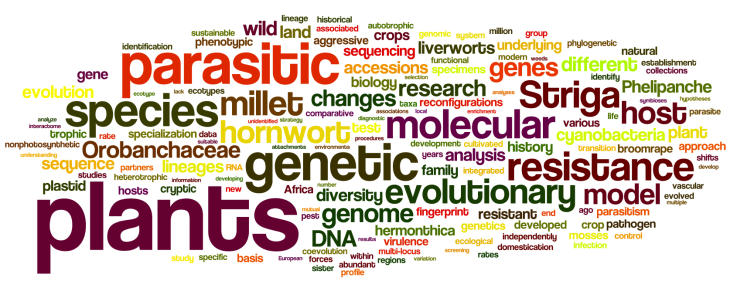
Nutritional specialization and host-related diversification in parasitic plants
We reconstruct the biogeography and ecological history of Orobanchaceae, test if host or abiotic environmental preferences, or both, have drive their diversification, and analyze the evolution of gene diversity en route to a fully parasitic lifestyle.
Genetic reconfigurations en route to a nonphotosynthetic lifestyle in plants
The goal of this research is to identify commonalities as well as adaptive and nonadaptive genetic reconfigurations that are associated with the transition from an autotrophic to a holoparasitic way of life within the Orobanchaceae.
Lifecycle synchronization between parasitic plants and their hosts
This project analyzes the function of gene complexes involved in flowering time regulation of Orobanchaceae. We will evaluate whether a shift from annual to perennial hosts, or vice versa, alters the life history preferences of the parasites.
Acclimation kinetics of a plant-plant-pathosystem
This research line investigates the ecological and molecular responses of biotically challenged plants to adverse environmental conditions. To understand the evolutionary conservation and role of environmental signal integration, parasitic plants of varying degrees of trophic specialization represent both the biotic stressors of model plants like Arabidopsis and tomato, while also being the focal point of this work.
Adaptations along the shift from photo-autotrophy to heterotrophy
Niche shifting to a permanent heterotrophic lifestyle facilitates the evolvution of highly adapted Chlamydomonas populations, whose specialist individuals exhibit an increased fitness under zero-light conditions .
Workflow to detect parasitic weeds in environmental samples
This research program aims to develop an integrated diagnostics procedure based on DNA (meta)barcodes extracted from genomic resources of wild and weedy parasites throughout the biodiversity range of Orobanchaceae.
Genetics of the hornwort’s carbon concentrating mechanisms
This project aims to understand the genetics of pyranoid formation in hornworts, which uniquely enables these enigmatic bryophytes to perform biophysical carbon concentration otherwise known only in algae.